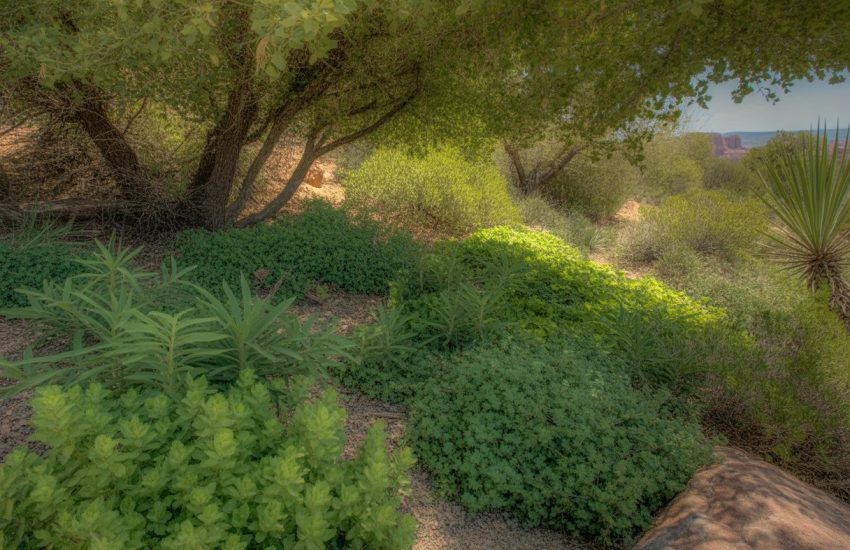Ground Cover Plants to Grow in Tennessee
Endowed with an ideal climate that provides plentiful sunshine and ample rainfall, Tennessee is teeming with a seemingly endless list of plants that flourish within its valleys, fields, forests, wetlands, and mountains. A single yard can provide many microclimates that are capable of nurturing numerous species of groundcover plants. After identifying the characteristics of an intended garden bed, ideal groundcovers can be mixed and matched to provide a beautiful, functional garden that will thrive for years to come.
Wild Strawberry (Fragaria Virginiana)

This opportunistic native strawberry reaches up to 6″ tall while simultaneously spreading through stolons, quickly filling in bare spots in the landscape as a sprawling cover. Wild strawberries are useful plants for humans, albeit not as desirable as their domesticated relatives. However, they’re much more resilient in the face of pests, disease, weather, and challenging cool growing conditions (they’re semi-evergreen), making them a lower maintenance, beginner-friendly choice. They tend to slow down as the hot weather phases in after flowering. This provides gardeners with an opportunity to sow seeds or transplant seedlings of hot weather “filler” plants that will thrive as the strawberries slow, providing additional cover for the garden and shade for the strawberries.
These plants flower during the late spring and early summer, providing food and refuge for many different beneficial insects. During the spring and fall, they are lush and green. They are one of a variety of host plants for aphids, providing a perennial food source, breeding ground, and hibernation zone for the renowned ladybug. The berries produced are an excellent food source for the local wildlife as well.
Lizard Tail (Saururus Cernuus)

Growing up to 36″ tall, this fierce, competitive native groundcover can be on the taller end, but is commonly 12″-24″ especially in cultivation. Lizard tail is a running perennial that spreads largely through rhizomes which can quickly outcompete other plants. However, it is able to thrive in two environments which pose a challenge to many other plants: extreme shade and waterlogged soil. If there is a low spot on a property that is shaded, this plant is an excellent ground cover choice.
The benefits of this low maintenance plant don’t stop there; it has a history of medicinal use within its native region, it’s an important food source in wetland environments for wildlife and insects, and it possesses a pleasing citrus-like aroma. During the summer, the long, unique flower spikes appear. this is where the name “Lizard Tail” comes from, as the spikes fall to the side closely resembling a lizard’s tail. There are many wonderful benefits to adding this native ground cover to the garden, especially in problematic spots that receive little light and too much water.
Allegheny Spurge ( Allegheny Pachysandra)

Allegheny spurge is more well-behaved than the lizard’s tail, as it’s a mounding perennial instead of an avid runner spreading via rhizomes. It thrives in shaded, moist areas, reaching a modest 12″ in height. This versatile plant is not only an exceptional green groundcover for filling in gardens or shaded areas, but also an attractive feature during the spring when it’s in full bloom with fragrant spikes of pink and white flowers.
The beautiful, serrated foliage is an excellent border planting for paths and bench areas. After flowering, the plants will begin sending up bright green foliage, coming to life as the days grow longer. As the new foliage matures and endures the summer heat, it darkens, followed by stunning mottling during the late summer and early fall. During the winter it remains largely evergreen, providing a small bit of color in the dreary, winter landscape. This remarkable ability to morph throughout the growing season is not the only amazing trait that Allegheny Spurge possesses; it’s also deer and drought resistant, while attractive to bees and predatory insects, alike.
Creeping Phlox (Phlox Stolonifera)
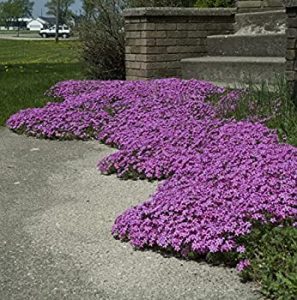
This particular shade-loving groundcover is commonly considered as nothing more than a spring wildflower; however, it’s an excellent dual-purpose plant that provides adequate ground coverage when planted densely. Rather than transplanting two or three established plants for the purpose of quick, large floral displays, gardeners can closely plant small seedling plugs to establish a mat of 6-8″ tall phlox rather quickly; the stolons spread and root amazingly fast in a new garden bed. For gardeners who need a juglone-resistant plant that can thrive beneath a black walnut tree’s canopy, creeping phlox is an excellent candidate.
Once established, creeping phlox boasts an exceptional display of stunning purple flowers during the spring. This plant is a very important source of food for pollinators during the spring, as it’s one of the first native plants to bloom. After flowering, the tiny, dark green leaves remain throughout the summer with an evergreen habit. In the milder winters of Tennessee, phlox is one of the first to begin showing signs of new life with tender young foliage before spring arrives.
Catsfoot/Pussytoes (Antennaria Dioica)

If one is searching for a tiny (4″ tall) enchanting groundcover that quickly becomes a conversation piece or focal point, catsfoot is a fun option. The small, delicate flowers have stamens that project outward, resembling the antennae of insects (resulting in the name Antennaria.) This plant can be a little harder to maintain and protect from rot in the native clay of Tennessee due to the water retention properties of clay, but the addition of sand quickly remedies this. On the flip side, it’s an excellent choice for gardeners who have incredibly rocky properties in the middle and eastern portions of the state, with an abundance of limestone and possibly native prickly pear cactus as well (where other plants don’t seem to thrive.)
This stoloniferous species is slow to spread at first but provides reliable spring groundcover once it becomes firmly established. The hottest parts of the Tennessee summer may see catsfoot retreating and slowing, but it will bounce back as the weather cools. It does best in a sunny, dry location, and is quite drought tolerant. As with other spring groundcovers, it’s an excellent companion for heat loving annuals and perennials that begin growing rapidly just as the catsfoot begins to wind down. As a final benefit for the home gardener, this plant is an important host species for the larvae of the American Painted Lady Butterfly.
Golden-Knee (Chrysogonum Virginianum)
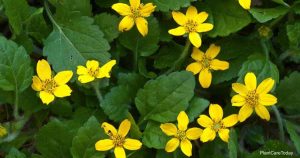
Forming a mat via rhizomatous growth, this short groundcover will offer two blooming periods with dainty yellow flowers surrounding the sweltering Tennessee summers. Much like dandelions and clover, golden knee will put on a large floral display in the spring, fizzle out during the summer, but rebloom again with a smaller display as the cooler nights of late summer and early fall arrive. Generally remaining within the 3″-4″ range, it will top out at 12″ in height as the flowers tower above the creeping foliage.
Thriving in partial to full shade, it’s a good option for northern plantings, woodland trails, or for planting beneath large canopies; it also loves acidic soil, which Tennessee is well known for. Since it roots aggressively and self-seeds fairly reliably, it is an easy plant to care for that won’t need a lot of maintenance aside from pruning on occasion. It is also considered to be very resistant to pests and disease, which can be problematic in moist, shady areas of the garden.
Three-Toothed Cinquefoil (Sibbaldiopsis Tridentata)
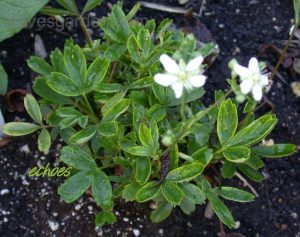
Three-toothed cinquefoil does not possess the creeping or sprawling habit of most typical groundcovers. Instead, it grows much like an herb with an upright habit reaching 10″ in height. When planted densely so that mature plants are “holding hands,” three-toothed cinquefoil will form a thick, reliable groundcover. Preferring dry or rocky soil that is on the acidic side, prime locations would include graveled driveway borders, rocky hillsides, or in raised rock gardens where water doesn’t pond. This is a groundcover that enjoys full sun, soaking up the intense summer rays. Since traditional creeping groundcovers typical grow as forest floor plants, they don’t take kindly to full sun; three-toothed cinquefoil is a consideration for plots in which other groundcovers have failed due to intense direct light.
Aside from enjoying lots of sunlight, this perennial wildflower will produce clusters of up to 25 white, elegant blooms in the spring with a long blooming period of 2-3 months. The distinct leaves are quite attractive, and the plants will “spill over” as they mature.
Seersucker Sedge (Carex Plantaginea)
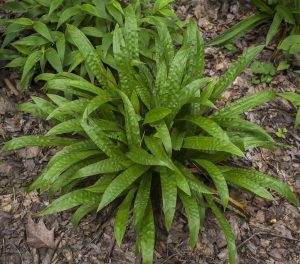
Seersucker sedge is a small, native, broad-leafed plant with a clumping habit that is quite attractive, commonly serving as an ornamental plant in naturalized spaces. When used in rural gardens, the beautiful foliage serves as a host plant for many native butterflies, while the seeds serve as a source of food for wild turkeys. With both being very abundant in the state, this plant is a good start for gardeners who are looking to help support the local wildlife in their own backyard.
This plant loves a balanced mixture of sun and shade, preferring moist soil. It is not an aggressive spreader, but it will slowly fill in bare areas through runners and self-seeding. Therefore, it pairs well with some other groundcovers that may be shorter in stature, resulting in an aesthetically pleasing garden bed that has plenty of variety.
Passionflower/Maypop (Passiflora Incarnata)
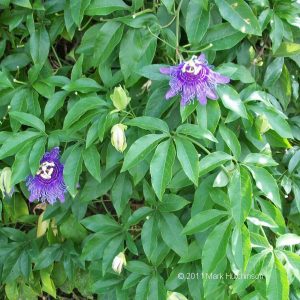
While passionflower vines aren’t traditional groundcovers with creeping growth habits, they are easily trained as low-lying vines that will quickly fill in a barren spot. These vines enjoy sunny locations, but are flexible with some shade, as well. Not only are they versatile natives that fuss very little, but they are also edible for people and wildlife alike. Maypops also produce absolutely mesmerizing, huge blooms that are untouched by any other plant on this list. The blooms smell wonderful, the flavorful fruits are the size of a small orange, and the foliage is bold, providing a nice contrast to other smaller plants.
Passionflowers are very resilient when faced with pests, disease, and drought. While it is technically a perennial plant, it is easily grown as an annual; for those who leave fruits in place, they quickly find that the passionflower easily reseeds itself, providing large numbers of volunteers in the following years.
Foamflower (Tiarella Cordifolia)
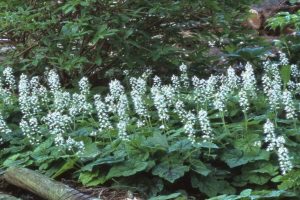
For a slower growing perennial that doesn’t quickly spread far and wide like the maypop vines do, foamflowers are a charming native pick. They spread through underground rhizomes, gently filling in their colonies over time. This small, herbaceous plant produces alluring 12″ flower spikes composed of delicate white flowers in the early spring. This plant is a little pickier about its growing conditions, preferring moist soil in adequate shade. Since this plant does not grow as vigorously as some of the other species on this list, it’s much easier to manage in smaller spaces with less pruning. Foamflowers are known for being deer resistant, while also attracting pollinating insects (bees, moths, butterflies) and a wide assortment of beneficial birds.
Planning Ahead Is Vital for Successful Groundcover Plantings
There is a wide assortment of beneficial, native, and attractive groundcovers available to gardeners in Tennessee. While each of the species discussed in this passage are excellent choices, it is important to focus on the microclimate of the planting area. If a plant is not compatible with its intended home, it may struggle to grow or perform as expected. Sometimes, even a distance of just 12 inches in transitional areas can have a significant impact on a plant’s ability to thrive. Tracking the sun’s progression over the course of a day, identifying shady areas, and tracking runoff during rainstorms will arm a gardener with a wealth of knowledge regarding their land and how it should be planted. This process helps to eliminate any plants that might not be a good fit.
Whether a gardener is trying to find plants for a low-lying ditch, a compacted graveled or rocky area, or a scorching ridge in a field, there’s a groundcover that can thrive in the wonderful climate that Tennessee has to offer.

